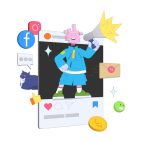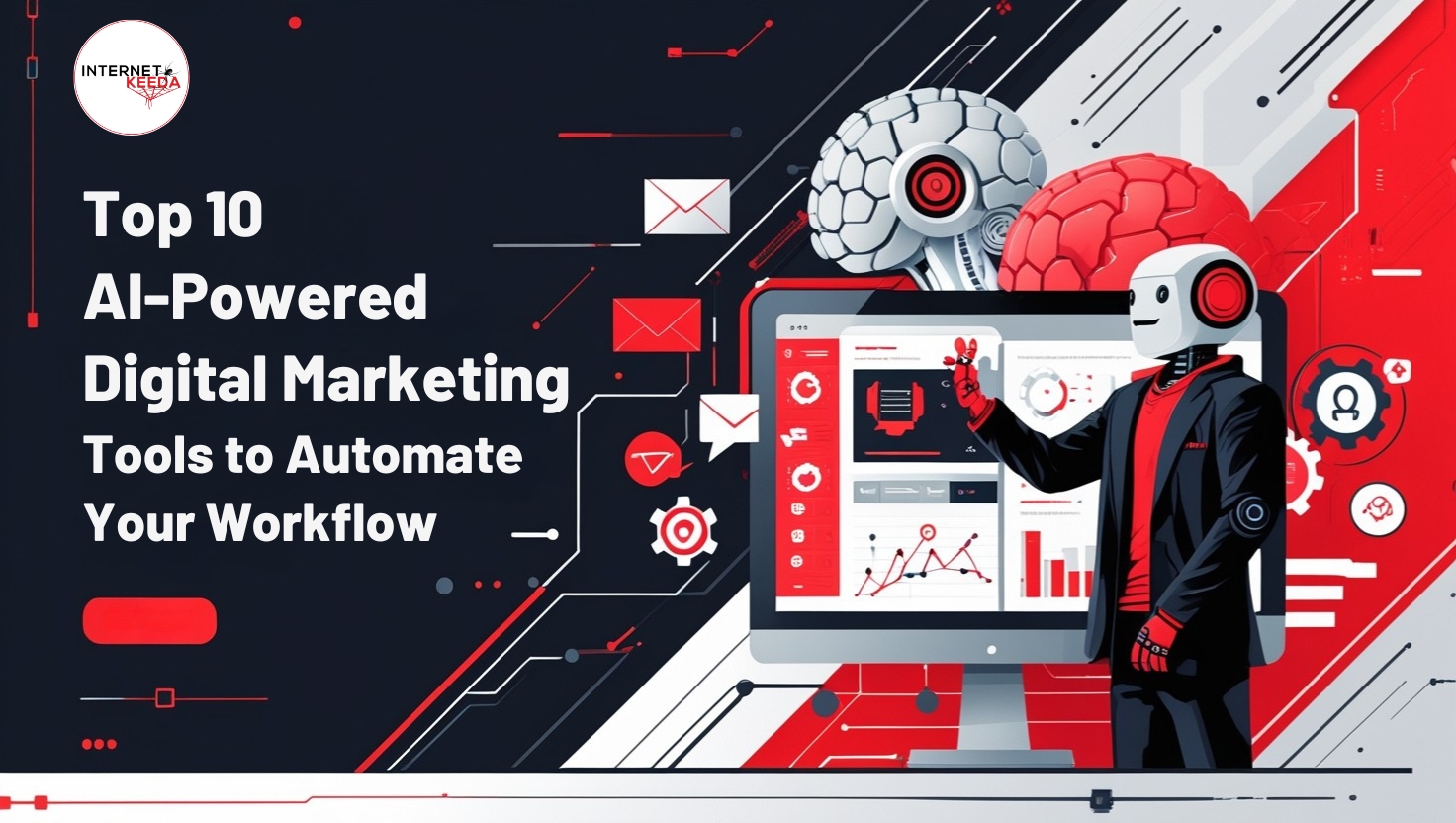Introduction: When Time Feels Like Your Biggest Competitor
You wake up, pour your coffee, and before you’ve even taken that first sip, your inbox is already begging for attention. Social posts need scheduling. Analytics reports need pulling. A client is asking if their latest blog went live. And somehow, your content calendar still sits half-empty. Sound familiar?
If you’re a freelancer, a small business owner, or part of a lean marketing team, that scramble isn’t unusual, it’s your norm. You’re constantly dancing between strategy and execution, hoping automation can lend a hand. The good news? It can. And not just any automation. We’re talking about the intelligent kind of AI-driven tools that don’t just save you time, but make you sharper, faster, and dare I say, even a little calmer.
In this article, we’re diving into ten standout AI-powered digital marketing tools reshaping workflows in 2024 and 2025. These aren’t hypothetical future-of-marketing concepts. These are real platforms marketers are using today to take control of their time, their results, and their sanity.
1. Jasper AI: Your Content Wingman
Jasper didn’t just jump on the AI bandwagon, it helped drive it. Originally known as Jarvis, this tool exploded in popularity when marketers realized they could delegate everything from blog intros to full-scale website copy to a writing assistant that didn’t burn out.
What makes Jasper stand out isn’t just its ability to write quickly. It’s how customizable and context-aware it’s become. You can feed it your brand voice, style guides, and audience personas. The result? Drafts that sound a lot more like you and less like a robot with a thesaurus.
In 2025, Jasper’s Business and Pro plans now include campaign planning, multi-user collaboration, and API integrations, making it a serious tool for agencies managing multiple clients. For solopreneurs, the Creator plan is more than enough to get weekly content rolling without feeling like a hamster on a wheel.
2. Surfer SEO: When AI Meets SEO Precision
Writing content is one thing. Getting it to rank? That’s a whole different game. That’s where Surfer SEO steps in, not just as a keyword checker but as a full-on optimization coach.
You paste your content draft into its editor, and within seconds, it tells you exactly what to improve based on real-time SERP data. Too few mentions of your main keyword? Missing semantic matches? Competitors using a phrase more frequently? Surfer lets you know.
In 2025, as AI-generated content floods the web, search engines are getting pickier. Surfer SEO helps you stay ahead by making sure your content isn't just readable, it’s rankable.
Real Stat: According to a 2024 Ahrefs report, pages optimized with Surfer’s NLP recommendations had an average 27% increase in organic traffic within 3 months.
3. GrammarlyGO: Polished Writing, Turbocharged by AI
Grammarly has been a household name in content polish for years, but GrammarlyGO, its AI-powered content assistant, takes things a step further. Instead of just fixing mistakes, it suggests rewrites, crafts new paragraphs, and adapts the tone based on your intent.
Imagine needing a formal client pitch rewritten in a more conversational tone. GrammarlyGO does it in a click. Need your CTA to pop more? Ask the assistant.
In a world where communication speed is critical but clarity is everything, GrammarlyGO strikes a perfect balance. It’s like hiring an editor who understands your deadlines.
Use Case: Many solo freelancers use GrammarlyGO to revise Upwork proposals, pitch emails, and social media bios. It’s like a writing partner that doesn’t ghost you.
4. Copy.ai: Idea Generation When the Tank’s on Empty
Some days, your brain’s on fire. Other days? Nothing but static. Copy.ai was made for those static days. It takes the pressure off brainstorming by generating ideas, headlines, product descriptions, emails, you name it.
For freelancers juggling clients in wildly different industries, Copy.ai is a lifeline. It saves hours you’d otherwise spend staring at a blank doc, trying to come up with the 17th way to say "We’re the best in the business."
5. Notion AI: The Digital Brain That Thinks
If your current project management tool feels like a to-do list with ADHD, Notion AI might just change your life. It’s where note-taking, writing, organizing, and planning collide, and now, the AI layer turns Notion into something scary-good.
Need a summary of a messy team meeting doc? Done. Want your brainstorm converted into a blog outline? Easy. Notion’s AI doesn’t just store your ideas. It organizes, expands, and transforms them.
With teams going remote and async-first, this tool’s collaborative power is helping marketing teams keep workflows smooth, clear, and forward-moving.
2025 Update: Notion’s integration with Slack and Google Drive means it now pulls references, attachments, and comments into one place automatically AI summarizes them into digestible briefs.
6. AdCreative.ai: Design Smarter, Not Harder
Ever feel like you’re spending more time designing ads than running campaigns? AdCreative.ai is like a personal designer that lives inside your laptop. It uses AI to generate ad creatives, headlines, copy, and images that are already optimized for performance.
It doesn’t just make things pretty. It looks at historical ad performance and tweaks new creatives accordingly. And because it's built with marketers in mind, you get formats ready for Google, Facebook, Instagram, and more.
Use Case: “I ran a test between my manually designed ad and one from AdCreative.ai. The AI version outperformed mine by 42% in CTR. I’m not mad, just humbled.”
7. Flick: Social Media Without the Burnout
Managing social media feels like feeding a beast that’s always hungry. Flick helps tame that beast. Originally a hashtag research tool, it’s evolved into a full-scale AI-powered social content engine.
It helps you plan, write, and schedule your Instagram content based on audience behavior and trend analysis. Its latest update? AI that rewrites your posts for different tones so you can turn a promotional caption into a witty one-liner or a motivational quote without rewriting from scratch.
Use Case: Flick helped one solo coach go from sporadic posting to 30 days of scheduled, analytics-informed content, planned in one afternoon.
8. HubSpot AI Tools: The CRM Just Got Smarter
HubSpot has always been a favorite for inbound marketers, but its recent AI integrations take it from smart to genius. We’re talking predictive lead scoring, AI-written email sequences, smart content recommendations, and even customer sentiment analysis.
Whether you're nurturing leads through email or building automated workflows, HubSpot’s AI removes guesswork from the equation. In 2025, it rolled out custom GPT-trained chatbots that feel less like clunky forms and more like your best sales rep.
Real Stat: According to HubSpot’s 2024 State of Marketing report, businesses using its AI-enhanced tools saw a 34% improvement in lead-to-customer conversion rates.
9. Semrush Copilot: Your Research Sidekick
Semrush has long been the Swiss Army knife of digital marketers. Its Copilot AI is like adding a brain to that knife. It suggests keywords, outlines your articles, generates competitive insights, and even flags new backlink opportunities before your competitors catch on.
For SEO professionals, it’s like having an intern who knows what they’re doing. It doesn’t just give you data, it gives you direction.
Use Case: Agencies using Semrush Copilot reported a 50% reduction in time spent on monthly SEO reports, freeing time for client strategy calls.
10. Zapier + OpenAI: The Automation Duo You Didn’t Know You Needed
Zapier has always been about connecting your favorite tools. But once you plug OpenAI into the mix, things get magical. You can now create Zaps that generate emails, summarize data, or even write social posts, all based on real-time triggers.
Let’s say a lead fills out a form on your site. Zapier grabs the info, feeds it to OpenAI, which writes a custom email based on what they said, and sends it. No human touches a thing. That’s what scalable personalization looks like.
Use Case: “I run an Etsy shop solo. Zapier+GPT writes thank-you notes and emails customers if a product is delayed. It’s saved me hours, and my buyers feel like they’re talking to a real person.”
Tips, Tricks, and Lessons Learned from the AI Marketing Trenches
Let’s talk about the stuff most tool reviews skip. The messy, behind-the-scenes reality of using AI in real workflows. While AI can transform how you market, it's not always as plug-and-play as the promo videos suggest. There’s a learning curve. There are moments when things break. And there’s a fine line between letting AI help you and letting it take over.
Here’s what seasoned marketers have figured out, sometimes the hard way.
First, don't try to automate everything at once. It’s tempting. You get excited, sign up for six new tools in a weekend, and think you’ll wake up Monday to a fully automated agency. But what happens? Overwhelm. Most marketers who find long-term success with AI start by solving one small pain point. Maybe it's just using Jasper to write weekly newsletters and or letting GrammarlyGO clean up blog posts. You build confidence in layers. One win at a time.
Also, context is king. AI works best when it has something solid to work with. Vague instructions lead to generic output. But if you feed it details about who your audience is, what emotion you want to evoke, and what the end goal is, that’s when it shines. Treat AI like a smart intern who’s incredibly fast but still learning your voice. The clearer you are, the better it performs.
Another trick that’s often overlooked? Use your data. Tools like Surfer, Semrush, and HubSpot don’t just spit out numbers. They’re trying to tell you something. If a page is ranking high but not converting, maybe your CTA is weak. If email open rates are flat but click-throughs are rising, perhaps the preview text isn’t doing its job. These aren’t just stats, they’re signals. And AI becomes a lot more useful when paired with thoughtful interpretation.
There’s also magic in blending tools. Notion AI and Copy.ai, for example, make a killer combo for content strategy. One helps you plan, the other enables you to create. Or try using Zapier with ConvertKit to personalize welcome emails based on how a lead answered a form. Small integrations, big impact.
But here’s the most human truth in all this: AI can’t replace your gut. It can optimize, speed up, suggest, and support. But it can’t feel. It can’t tell you when something just doesn’t sound right. Or when a campaign needs to pivot because your audience’s mood has shifted. That part is still yours. It always will be.
One freelancer I spoke to put it perfectly. “AI made me faster, not better. I had to become better on my own. But once I did, AI made that better, more scalable.”
So here’s your friendly reminder. These tools are powerful, but they don’t make the marketer. You do.
Building an AI-Powered Marketing Workflow That Feels Human
At some point, every marketer hits that wall, the one where you’ve got too much to do, too many platforms to manage, and not nearly enough hours in the day. That’s usually when the “I need AI” thought kicks in. But let’s be honest: integrating AI into your marketing workflow can feel overwhelming. Not because the tools don’t work, but because the process of stitching them together often feels like learning to fly a plane mid-air.
But here’s the truth. You don’t need to go all-in from day one. You just need one task. One single, repetitive thing you already do is your starting point.
Let’s say that task is writing weekly blog posts. It sounds simple, but when you unpack it, there’s research, outlining, drafting, editing, SEO optimization, publishing, promotion, and finally tracking performance. That’s at least six different steps. It’s no wonder you’re burnt out before the second paragraph is written.
This is where your AI workflow begins.
You could start by letting Jasper help you draft the outline and intro paragraph. Once you’ve got the rough skeleton, Surfer SEO steps in to guide keyword placement and competitor benchmarks. GrammarlyGO polishes your draft and helps rewrite awkward phrases. When it’s ready, you schedule it in WordPress, and Zapier fires off an automated email via ConvertKit to alert your subscribers. Meanwhile, Flick or Metricool posts it to social, and Notion logs the content for your internal archive.
Suddenly, what used to take you two full days is down to half a day, with your energy still intact.
But here's the secret: this isn't about replacing yourself. It’s about removing the exhausting parts of the process so that your brain, your ideas, and your creativity can breathe. It’s about creating space for you to be the strategist again, not the technician.
Too many marketers fall into the trap of chasing shiny new tools, thinking they need to be on every platform and automate every action. But more tools don’t always equal more results. What matters is having the right tool to do the right job in a way that supports how you work.
For example, if social media drains you, then tools like Flick and Buffer can step in to write and schedule your posts, but your voice should still shine through. If managing leads is the pain point, HubSpot's AI can score and segment them so you don’t waste time chasing cold traffic.
A solo creator I spoke with recently told me, “I don’t need AI to be smarter than me. I just need it to help me show up when I’m tired or stuck.” And that’s it. That’s the whole point.
AI isn’t here to replace marketers, it’s here to support the emotional labor of showing up consistently. Because let’s face it, the hardest part of digital marketing isn’t strategy. It’s being consistent. It’s staying present. It’s pushing through creative fatigue and impostor syndrome and algorithm changes, all while trying to grow something meaningful.
So, build your AI workflow like you’d build a team. Slowly. Intentionally. One role at a time.
Start with the thing that drains you most and hand that off. Then build out. Let it evolve. Let it be messy for a while. The goal isn’t to become a machine. It’s to use machines to be more human in how you work, connect, and grow.
What Most Marketers Get Wrong About AI And How to Avoid It
Let’s be real, AI is having its moment. It's no longer a futuristic concept whispered about in tech conferences. It’s in your writing apps, your email platform, your analytics dashboard, and probably in three tools you didn’t even know were powered by it. But with this wave of excitement comes confusion, and for many marketers, missteps that waste time, money, and momentum.
One of the biggest mistakes? Trying to do too much, too fast.
You sign up for five tools in a week: Jasper, Surfer, Copy.ai, Zapier, HubSpot, and suddenly your marketing feels like managing a software jungle. You’re jumping between tabs, running half-finished automations, and wondering why your results haven’t changed.
Here’s the truth: AI doesn’t fix chaos. It amplifies whatever system you already have. If your process is disorganized, adding automation just makes the disorganization faster.
The fix? Slow down. Start small. Choose one part of your marketing that feels repetitive and painful, something that steals your time and energy every week. Then ask: Is there a tool that can take this off my plate without compromising quality?
For some, that means handing off social captions to a tool like Flick. For others, it’s using Jasper to draft blog outlines or letting GrammarlyGO reword awkward client proposals. One task, not ten. Master it, systemize it, then move on.
Another trap is leaning so hard on AI that you start sounding like everyone else.
We’ve all read it, the blog post that checks all the SEO boxes but feels... soulless. The Instagram caption that says the right thing, but says it like a robot wearing a blazer. That’s what happens when you let AI write without context, without you.
AI is an assistant, not a replacement. The magic happens when you give it your tone, your stories, your rough ideas, and let it shape something better. But if you treat it like a vending machine for perfect content, you’ll end up with work that checks the boxes and still falls flat.
And then there’s the data problem, or rather, the over-reliance on it.
Modern tools feed you insights on everything: click-through rates, engagement drops, sentiment shifts, and scroll depth. It’s useful until it isn’t. Because when you’re drowning in analytics, it’s easy to forget that marketing isn’t just performance metrics, it’s about building real relationships.
Don’t let numbers blind you to nuance. Just because a tweet flopped doesn’t mean the message was wrong; maybe it just needed a different hook. Just because one email had a low open rate doesn’t mean your list isn’t listening; maybe it landed on a bad day. Use data to guide your curiosity, not your self-worth.
The point is this AI can be powerful, but only if you’re still in the driver’s seat.
Let it assist, organize, and optimize. Let it take the heavy lifting off your shoulders. But don’t lose your voice in the process. Don’t trade creativity for efficiency. The best marketers in 2025 won’t be the ones who automate the most; they’ll be the ones who use AI to deepen their human touch, not replace it.
A Week in the Life of a Marketer Using AI the Right Way
Imagine it’s Monday morning. You sit down at your desk with a plan, not panicking. Instead of juggling ten tools and fifty to-dos, you open the few that help you move the needle. This is what a real, manageable, AI-powered marketing week can look like when it’s done intentionally.
You start by opening Notion, where your content calendar lives. It’s already structured from last week because Notion AI helped summarize your meeting notes and build it out. You glance at your goals, your key topics, and the audience segments you're targeting. No chaos, just clarity.
Next, you move into brainstorming mode. You need a new blog post idea. Jasper steps in to help, suggesting three timely topics based on the keywords you're focusing on. One of them sparks something, so you start drafting. Jasper gives you a full outline. You tweak it, shape the voice to match your tone, and within an hour, your first draft is nearly done.
Before publishing, you paste the draft into Surfer SEO. It tells you what to add and where, showing you exactly how to align it with top-ranking content. A few small edits later, you’ve got something that’s not just well-written but SEO-optimized and ready to rank.
Tuesday is your social media day. Instead of manually writing five different captions, you open Flick. It analyzes what’s trending with your audience and offers caption ideas based on that. You customize them to match your voice, schedule them out using Buffer, and close the tab feeling ahead of the game instead of behind.
By midweek, your inbox is full, and it's time to respond to leads. Instead of typing every message from scratch, GrammarlyGO helps you rewrite replies that sound polished and professional but still feel like you. You still personalize each one, but it saves you from rewriting the same message a dozen times.
On Thursday, you check your campaign analytics. You open HubSpot. Its AI shows which contacts are most engaged and which emails led to the most clicks. It even recommends a follow-up email for people who clicked but didn’t convert. You approve the suggestion, make a few adjustments, and schedule it to go out tomorrow.
Friday is your review day. You pull up Google Analytics and check what content performed best. Semrush Copilot alerts you to a new keyword opportunity based on what your competitors just started targeting. You make a quick note in Notion to build next week’s strategy around it.
Then something amazing happens. You realize the whole week ran smoother. Less stress. More clarity. No wasted hours switching between apps or fixing broken processes. You had more time to think, to write, to engage. That’s the difference intentional AI makes.
It’s not about automating everything. It’s about choosing the right tools, using them in the right way, and building habits around them that support your growth. You’re not chasing trends. You’re building a system. And that’s how real marketing momentum starts.
How Smart Marketers Repurpose Content with AI (Without Burning Out)
Let’s be honest. You don’t always need more content. What you need to do is to do more with the content you already have. And that’s where AI becomes less of a novelty and more of a secret weapon.
Take a single blog post. You wrote it last week. It took hours of thought, editing, and maybe a few cups of coffee. Most marketers hit publish, share the link on social once, and move on. But the smart ones? They know that the post isn’t finished working yet. It’s just getting started.
Here’s how a modern content repurposing loop works.
You start with that one blog. Drop it into Notion AI or Jasper and ask for a short-form version. Something punchy for Instagram or LinkedIn. You take the AI's draft, polish it to sound like you, and schedule it using Buffer or Flick. Suddenly, your blog becomes a week’s worth of social posts.
Next, you ask Copy.ai to turn the blog into an email. Not just a summary, but something that feels personal. Something that speaks to your list directly. You take the bones of that draft, wrap your voice around it, and load it into MailerLite or ConvertKit. That’s your newsletter done.
Still not done. You feed the post into an AI video tool like Pictory or even ChatGPT Vision, paired with your slides. Out comes a script or storyboard. You record a short video, upload it to YouTube Shorts or Instagram Reels, and now your blog has turned into visual content, too.
Every piece of the original content gets multiplied. One idea becomes seven touchpoints. One morning of work becomes an entire week’s worth of value. The only thing you’re doing differently is giving AI a seat at the table. It’s not replacing your creativity. It’s stretching it.
The best part? You’re not burning out. You’re not spending your nights scrambling to write one more caption. You’re not stuck in the content rat race. You’re making your work work harder.
It’s a shift in mindset more than anything. Instead of always asking “What should I post next?” you're asking “How else can I say what I’ve already said?” And with AI, you’ll find the answers a lot faster than you think.
Where AI Goes Wrong: Common Mistakes Marketers Still Make
For all the magic AI brings to the marketing table, it’s not a silver bullet. It’s a scalpel, not a hammer. Used right, it’s surgical. Used wrong, it’s sloppy. And if you’ve ever cringed at a chatbot’s awkward grammar or seen a LinkedIn post that feels more bot than human, you know what I mean.
One of the biggest mistakes marketers make with AI is trying to replace their voice instead of enhancing it. They lean too hard on automation. Let AI write every blog. Generate every email. Draft every caption. And what comes out might look good on the surface, but something’s missing underneath. The soul. The point of view. The experience that builds trust.
AI can mimic tone, but it can't tell your stories. It can't know how it felt to lose a client and bounce back. It can't share what it was really like building a brand from a rented desk in a noisy coworking space. And that’s what people connect with. That’s what they remember. That’s what builds a following that sticks.
Another mistake? Using too many tools, too soon. It’s easy to get caught in tool overload. Jasper for content. Surfer for SEO. Notion for planning. Zapier for automation. Flick for social. Before long, you’re managing five dashboards, three logins, and zero energy.
The smarter move is to start lean. Master one or two platforms deeply. Build your system. Then, expand only when the workload demands it. Not because a blog told you “all serious marketers use 10 tools.”
And here’s a silent killer of momentum: outsourcing your judgment. AI is helpful, no doubt. But it doesn’t know your audience like you do. It doesn’t know that your audience hates clickbait subject lines. Or that your community responds best to behind-the-scenes posts, even if they’re messy. Let AI suggest. Let it draft. But you decide. Always.
Because the real danger isn’t that AI will replace marketers. It’s that marketers will forget to bring their full selves into their work, thinking the tools can do it all for them.
No tool will tell you when a piece of content truly resonates. That’s your job. That’s your instinct. That’s the part of the process no one can automate.
The Balance That Wins: Automation With Authenticity
The best marketing today doesn’t feel automated. It feels intentional. It sounds human. It builds trust without pretending to be perfect. That’s the sweet spot, and AI can help you get there, but not if it leads the way. You still need to drive the story.
So what does that balance look like in practice?
It’s using AI to write your rough drafts, but editing them with your voice. It’s automating your content calendar, but still blocking time every week to show up live, reply to DMs, comment on posts, and talk to people.
It’s building automated email sequences that sound like a real person wrote them, with real stories and real pacing. Not some “Hi {first name}, here’s what you should buy today” formula.
It’s created with the help of machines, but it connects like a human. That’s what turns views into relationships. What turns traffic into trust?
If AI is your paintbrush, your vision still drives the painting. If it’s your co-pilot, you’re still steering the ship.
The people who win in 2025 won’t be the ones who use AI the most. They’ll be the ones who use it the best. Who brings strategy, clarity, empathy, and creativity to the table and lets the tools make the work easier, not emptier.
Real-World Reflection: A Freelancer's Perspective
I’ll be honest. When I first started using AI in my content workflow, I felt guilty. Lik, I was cheating. I worried that maybe I wasn’t “writing” anymore. Maybe I was just editing machine words and hoping no one would notice.
But over time, I saw something shift.
Instead of burning three hours trying to write a blog post from scratch, I could create a decent draft in twenty minutes, then spend the rest of my time shaping it. Adding my tone. Adding stories. Adding strategy. And weirdly, the quality got better, not worse. I wasn’t doing less. I was doing smarter.
And I wasn’t spending my Sunday nights buried in Canva, scrambling for one more Instagram post. I had space. To think. To plan. To be creative. To rest.
That’s the kind of balance that’s possible when you treat AI as an assistant, not a replacement. It won’t make your brand. But it will give you more energy to build it yourself.
Final Takeaway: You’re Not Competing With AI, You’re Creating With It
Let’s zoom out for a second. All these tools, platforms, dashboards, and metrics can make marketing feel more complex than ever. And sure, the industry’s changing fast. AI’s evolving. Algorithms keep shifting. But the heart of marketing hasn’t changed at all.
People still crave connection. They still buy from people they trust. They still respond to stories more than sales pages. They still want to feel like someone sees them, gets them, and is trying to help, not just sell.
That’s your job. That’s the opportunity AI can’t replace.
In a world full of noise, speed, and shortcuts, the most powerful thing you can do is show up consistently and truthfully. Use the tools. Embrace the technology. But never forget your voice is what makes your work unforgettable.
Whether you’re just starting or scaling fast, AI is here to support your journey, not define it. The real magic happens when you blend automation with intention. When you trust your instincts. When you put care into every post, every email, every sentence, even if a machine helped you write the first draft.
So here’s your permission to create at your pace. To work smarter. To tell your story. And to use every tool in your toolkit to make your mark.
Because you don’t need to sound like everyone else.
You just need to sound like yoy, confidently, and consistently.
And AI? That’s just the mic that helps your message reach farther.
 Bundles
Bundles Flash Sales
Flash Sales






















Comments (0)